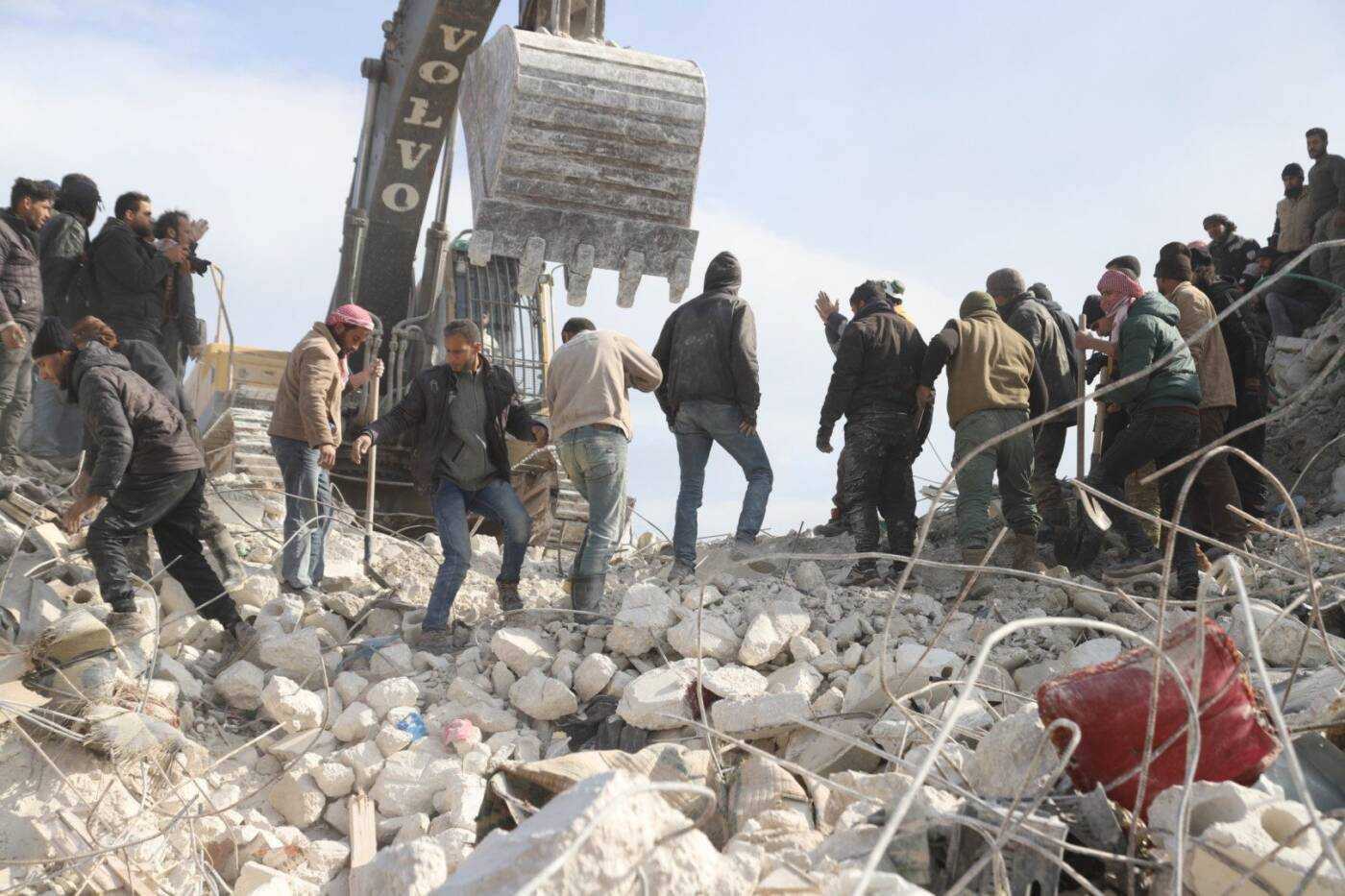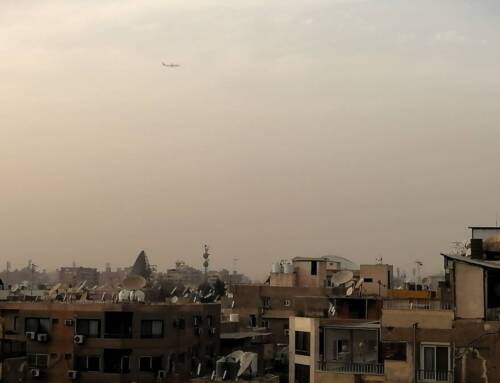In northwestern Syria, the afflicted rush to each other’s aid amid international community’s inaction
Racing against time, civilian survivors of the earthquake in northwestern Syria helped search through the rubble, bury the dead and care for the living this week, driven by feelings of responsibility for their community and the lack of an immediate international response.
10 February 2023
IDLIB, PARIS — In the minutes after the earthquake that struck Syria and Turkey before dawn on Monday, Muhammad Abu Talal and his family ran out of their house and headed for neighboring farmland. They made it out before the walls of their building cracked, while those around it collapsed to the ground in the northern Idlib countryside city of Sarmada.
Abu Talal was safe with his family, but he could hear shouts, a voice yelling “get me out, get me out,” he told Syria Direct. As rain fell, he left his wife and four children sitting on the ground, and went back to search for the source of the sound. It turned out to be his neighbor, Said.
Before teams from the Syrian Civil Defense (the White Helmets) arrived on the scene, Abu Talal and young men from the neighborhood started removing the rubble themselves. Using hand tools, they managed to “get eight people out, including three children,” he said. Two of those they pulled out “passed away before we could get them,” he added. He continued to help rescue teams, without stopping, until Tuesday evening.
In the first five days following the devastating February 6 earthquake, no rescue teams or equipment crossed the Turkish border into opposition-held northwestern Syria—with the exception of a small Spanish team that entered on February 9 and began work the following day, and a 17-member Egyptian team that arrived earlier in the week. For days, no international humanitarian aid arrived either, until two United Nations convoys entered on Thursday and Friday.
Without outside help in the critical hours and days following the earthquake, civilians who were themselves impacted by the disaster have rushed to respond and help fill the gap. Volunteers are removing rubble, transporting the injured, equipping relief centers and preparing meals. They have also buried hundreds of victims of an earthquake that, as of Friday, has killed 3,384 people across Syria, including 2,037 killed and 2,950 injured in northwestern Syria alone, according to a statement issued by the Syrian Civil Defense.
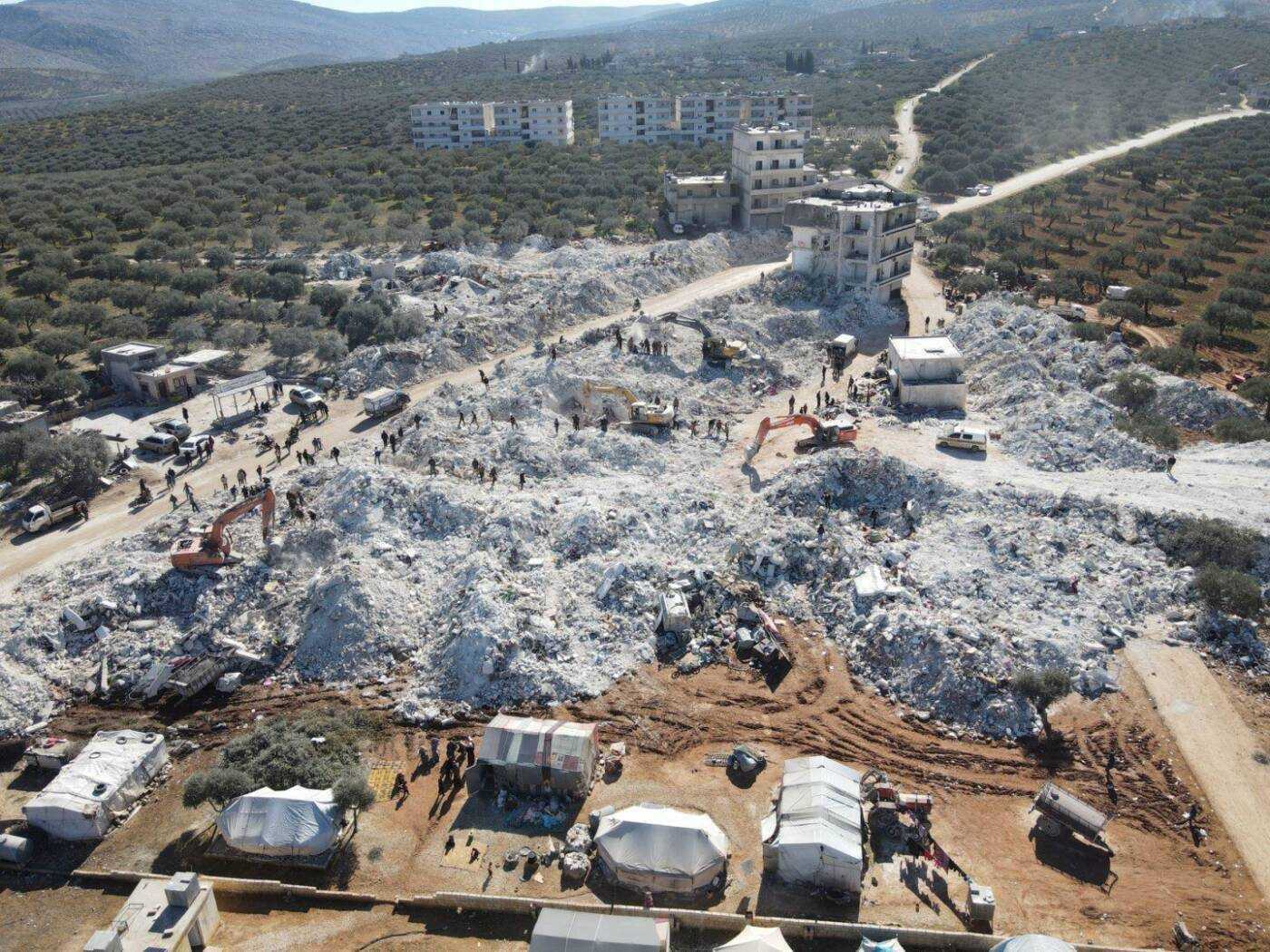
Destruction caused by the February 6 earthquake in the Idlib countryside village of Besenya, as well as a number of shelters for impacted residents, 9/2/2023 (Abd Almajed Alkarh/Syria Direct)
Within 40 minutes of the earthquake, Idlib residents came together to form an initiative, organized on social media and WhatsApp groups, to coordinate support for those impacted, said Hassan al-Idlibi, one of the network’s 70 members.
Al-Idlibi also helped with rescue operations in the Idlib countryside village of Besenya. “Rescue operations are something human, work that makes you feel the value of being there, with your people, in the disaster areas,” he said.
‘Our tragedy is one’
When the sun came up on Monday, Obada left his house in northern Idlib—where he has lived since being displaced from the Damascus countryside—to survey the damage. He expected to find “one or two buildings collapsed, maybe three.”
But when the 30-year-old arrived in Jenderes, in the Afrin district of the northern Aleppo countryside, he was surprised by the scale of the destruction. It seemed to him that “it included three-fourths of the city,” he told Syria Direct. The Jenderes Local Council said on Thursday that 257 buildings in the town were completely destroyed, 1,100 were damaged and that 756 people there died.
Civil defense teams were already on the ground in Jenderes when Obada arrived, but “the scale of the destruction was greater than their capabilities, and the machinery was nothing before the horror of the catastrophe.” He and others “tried to help as much as we could, though we aren’t civil defense volunteers and have never done this before,” he said.
Racing against time and “an unbearable situation,” civilian volunteers rushed to buy simple hand tools—shovels and sledgehammers—or buy fuel to run generators. They aimed to “lighten the load, as much as possible, for the civil defense,” Obada said.
Obada and other volunteers in Jenderes kept working for 48 hours straight. “We were trying to do anything, from removing rubble to transporting the injured,” he said. They worked without rest, “around the clock, in the hope of saving the lives of those trapped under the rubble.”
Helping is a natural reaction, and “what matters is to have some sense of how to deal with these circumstances,” said Abu Talal, who was displaced to the northwest from the southern Damascus countryside town of Darayya in 2016. “Participating in the rescue operation is a human duty, everyone has a responsibility,” he said, because “our country is one, and our tragedy is one.”
Obada denounced the lack of response from the international community to Syrians’ pleas for immediate intervention to help remove rubble and search for earthquake survivors in the northwest. “There are many people who were alive, but died before we could get them out,” he said.
Munir Mustafa, the Deputy Director of the Syrian Civil Defense, praised civilians’ efforts to help in recent days. “The situation would be much more catastrophic than it is now, if not for the social situation, civilians networking and forming teams of volunteers,” he said.
“The people who participated in rescue operations are helping save their loved ones, and their involvement has been effective, to some extent,” Mustafa said. It would be more effective “if there were heavy machinery and specialized equipment for rescue operations.”
But while help is needed, untrained people on the ground can create challenges for rescuers. Volunteers can “pose a danger to themselves, to the rescue teams and to those trapped under the rubble,” Mustafa said, so “the civil defense is trying to keep civilians out of dangerous locations.”
He called for people to “cooperate with us and follow our directives,” as “we are in a situation where it is impossible for us to train people—it’s a catastrophic time, and we don’t have the luxury of talking about training.” The Syrian Civil Defense has trained some civilians in the past, however, “and these people played a major role in responding to the earthquake, whether providing first aid or rescuing,” Mustafa said.
Any action ‘makes a difference’
The work of rescuing people and removing rubble is often the most visible part of emergency response efforts to disasters such as the earthquake in northwestern Syria. But it is one part of a long chain of efforts needed to support the people affected, including those who are now homeless, and displaced to temporary shelters.
Reem al-Masri, 32, is one of a number of female Idlib University students who have banded together to support those affected by the earthquake. Since Monday, they have collected donations and posted emergency phone numbers and information about shelters ready to receive displaced people over social media and WhatsApp groups, she told Syria Direct.
They have helped “secure vehicles to transport the survivors and deliver clothing and blankets to displacement sites,” as well as to “deliver food and drink to those affected and the volunteers,” she said.
Asal Mashan, 30, who is originally from the city of Jisr al-Shughour in the western Idlib countryside, has been doing the same—distributing clothes and blankets to shelters in Idlib city where she lives, and helping provide food to people sleeping out in streets and parks.
“You don’t need to think or be trained,” she said. Any action “makes a difference in this catastrophic situation.”
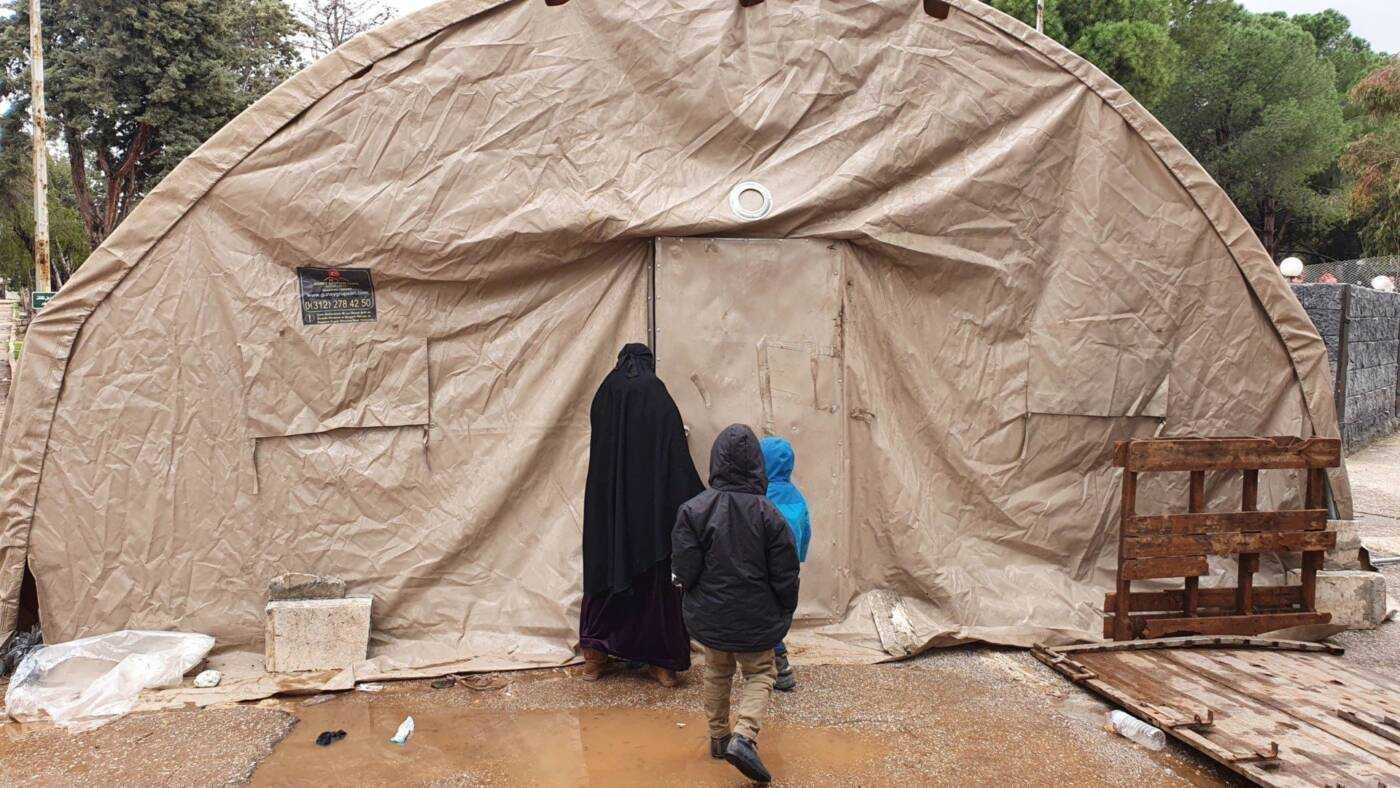
A woman and two children enter a temporary shelter in Idlib city, 7/2/2023 (Abd Almajed Alkarh/Syria Direct)
Mashan is happy to be helping the way she is now, and did not think to help pull people out from under the rubble, for fear of “dealing with them in the wrong way,” she said. Al-Masri tried to help rescue people under the rubble, but “the civil defense and authorities in the area refused, for fear of the risk or that we would obstruct the work,” she said.
In addition to caring for the living, burying the dead is a major challenge facing civil defense teams and other personnel in the face of a disaster that has claimed the lives of thousands of Syrians, both inside the country and in southern Turkey.
Here, too, civilian volunteers are playing a role. Ali al-Khalaf, 30, who lives in the Atma region on the Syrian-Turkish border, has formed a team of 13 men and two women to dig graves and secure items, such as shrouds, needed for burial.
Al-Khalaf is from the Hama countryside city of Kafr Zita, and since he first came to Atma in 2012, he has volunteered in different ways, depending on what was needed. After Monday’s earthquake, he started out by reporting news of the earthquake to the residents of the camp where he lives. As aftershocks continued, he also passed along information about how to deal with earthquakes—such as staying away from concrete buildings—and then initial needs assessments.
He went to Jenderes to inspect the damage, less than seven kilometers away from Atma. When body recoveries began, he and his team started digging graves. By Thursday evening, they “buried more than 400 people.”
Etched into memory
Painful scenes and images from Syria and Turkey have circulated widely in local and international media since the earthquake struck on Monday. But there is a phrase Syrians often say: “Seeing isn’t like hearing.” Watching from afar is very different from living an event, or being an eyewitness on the ground where it happened.
The disaster took a heavy toll on northwestern Syria, an area already grappling with conflict, displacement and health crises, where more than four million people live, half of them displaced. Over the course of responding to the disaster, volunteers described a number of moments that will remain etched into their memories.
For Abu Talal, the most difficult moment was when he tried to save his friend, media activist Ghiath Rajab Abu Ahmad, from his hometown Darayya, from under the rubble. He managed to “get his wife out, and she guided us to where her son and husband were,” he recalled. “I was able to save his son Ahmad, but Ghiath had passed away.”
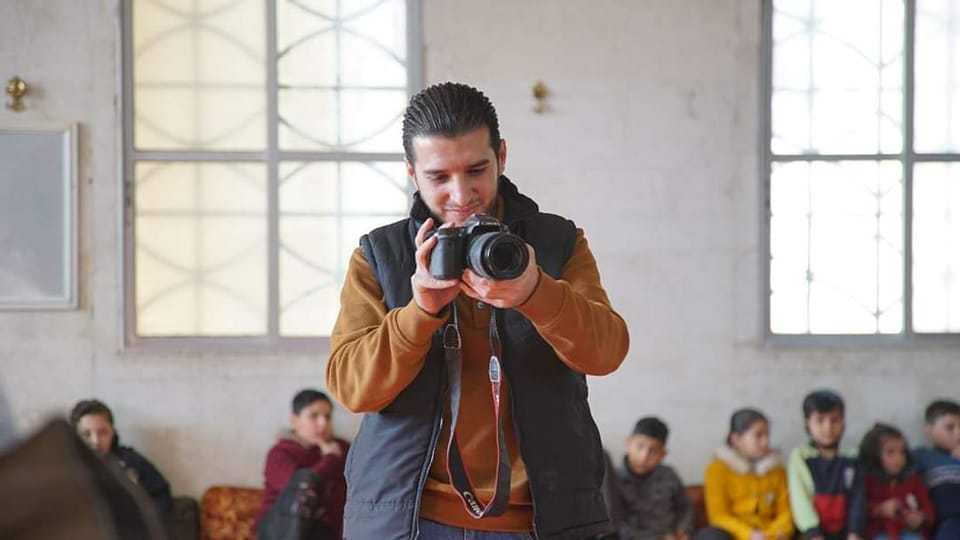
An archival photo of media activist Ghiath Abu Ahmad in Darayya city, in the south Damascus countryside, before he was displaced to northwestern Syria (Web)
And in Jenderes, Obada remembered the first day of the earthquake, when—searching under the rubble—they found “a father hugging his wife and children, in the hope of protecting them from the earthquake,” he said. “They all died together.”
Even after death, there are new, individual tragedies. Al-Khalaf told the story of a man who came to bury his son at 2 am on Tuesday, February 7. He remembers telling the father that his son should be washed and wrapped in a shroud before burial. The man began to cry, saying “I can’t afford a shroud.” The burial team paid for everything instead, he said.
“People were alive, and they died,” Murshan said, directing her comment at the international community and neighboring countries. “We don’t want anything from you. We have people and brethren abroad who can support us, but give us the freedom [to provide for] our needs, without restriction.”
“What are you waiting for?”
This report was originally published in Arabic and translated into English by Mateo Nelson.

